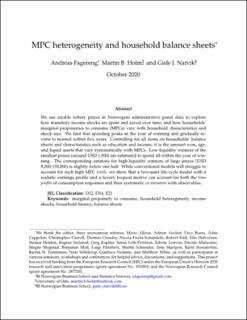MPC Heterogeneity and Household Balance Sheets
Journal article, Peer reviewed
Published version
Permanent lenke
https://hdl.handle.net/11250/2986430Utgivelsesdato
2020Metadata
Vis full innførselSamlinger
- Scientific articles [2181]
Originalversjon
American Economic Journal - Macroeconomics, 2021, Vol. 13 No. 4 10.1257/mac.20190211Sammendrag
We use sizable lottery prizes in Norwegian administrative panel data to explore how transitory income shocks are spent and saved over time, and how households’ marginal propensities to consume (MPCs) vary with household characteristics and shock size. We find that spending peaks in the year of winning and gradually reverts to normal within five years. Controlling for all items on households’ balancesheets and characteristics such as education and income, it is the amount won, age, and liquid assets that vary systematically with MPCs. Low-liquidity winners of the smallest prizes (around USD 1,500) are estimated to spend all within the year of winning. The corresponding estimate for high-liquidity winners of large prizes (USD 8,300-150,000) is slightly below one half. While conventional models will struggle to account for such high MPC levels, we show that a two-asset life-cycle model with a realistic earnings profile and a luxury bequest motive can account for both the time profile of consumption responses and their systematic co-variation with observables.
